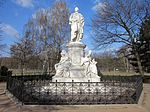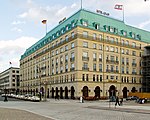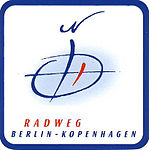Memorial to the Murdered Jews of Europe

The Memorial to the Murdered Jews of Europe (German: Denkmal für die ermordeten Juden Europas), also known as the Holocaust Memorial (German: Holocaust-Mahnmal), is a memorial in Berlin to the Jewish victims of the Holocaust, designed by architect Peter Eisenman and Buro Happold. It consists of a 19,000-square-metre (200,000 sq ft) site covered with 2,711 concrete slabs or "stelae", arranged in a grid pattern on a sloping field. The original plan was to place nearly 4,000 slabs, but after the recalculation, the number of slabs that could legally fit into the designated areas was 2,711. The stelae are 2.38 m (7 ft 9+1⁄2 in) long, 0.95 m (3 ft 1+1⁄2 in) wide and vary in height from 0.2 to 4.7 metres (8 in to 15 ft 5 in). They are organized in rows, 54 of them going north–south, and 87 heading east–west at right angles but set slightly askew. An attached underground "Place of Information" (German: Ort der Information) holds the names of approximately 3 million Jewish Holocaust victims, obtained from the Israeli museum Yad Vashem.Building began on 1 April 2003, and was finished on 15 December 2004. It was inaugurated on 10 May 2005, sixty years after the end of World War II in Europe, and opened to the public two days later. It is located one block south of the Brandenburg Gate, in the Mitte neighborhood. The cost of construction was approximately €25 million.
Excerpt from the Wikipedia article Memorial to the Murdered Jews of Europe (License: CC BY-SA 3.0, Authors, Images).Memorial to the Murdered Jews of Europe
Cora-Berliner-Straße, Berlin Mitte
Geographical coordinates (GPS) Address External links Nearby Places Show on map
Geographical coordinates (GPS)
| Latitude | Longitude |
|---|---|
| N 52.513888888889 ° | E 13.378888888889 ° |
Address
Denkmal für die ermordeten Juden Europas (Holocaust-Mahnmal)
Cora-Berliner-Straße 1
10117 Berlin, Mitte
Germany
Open on Google Maps











